Posted: 4/20/18
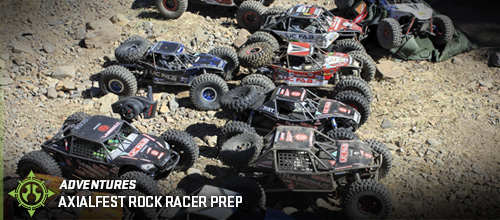
If you are a regular follower of the Axial Blog and we know you are, you probably saw the Trail Rig Prep blog for Axialfest. It’s loaded with great tips to help trail truck drivers and don’t think we forgot about you Rock Racers either. Rock Racing is a whole other experience at Axialfest and prepping a rig for the Rock Racing course or the Altra Ultra 5K can require a bit more preparation than a trail rig. Trail rig courses are not timed anymore at Axialfest and its a run at your own pace experience. But for Rock Racing and the 5K, there is much more on the line. Although they are fun events, there are prizes at the end for the winners and so you want to spend a bit more time making sure your rig is ready for what it is about to endure. We’ve altered our suggestions just a bit here, so if you read the previous trail blog, you should reread everything seen here.
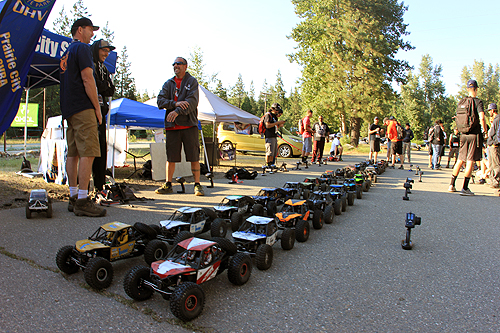
Hardware Check
Set-Screws- Set-screws can be a headache in the RC world, they are used in several areas on just about any rig. The most common is the pinion gear. If the set-screw goes into metal, it’s a good idea to add some blue thread locking compound to it before installing it. The thread locking compound is a measure to ensure the screw doesn’t back out during use. Most people use a blue thread locking compound which is serviceable, but in a Rock Racing competition, some have been known to use Red which is a permanent compound. Some heat can be used in the future to help break free hardware secured with red thread lock.
Lock-nut- Sometimes standard nuts are used in several locations on a rig and perhaps you’ve installed a nut or two along the way while working on or customizing your truck. Consider swapping out all standard nuts with ny-lock nuts. These nuts have a plastic insert ring that helps prevent the nut from backing off of the screw. You may also want to consider using threadlock compound as an additional way to secure the nut and some have even gone as far as installing two nuts to secure bolts in place.
Machine Screws- Machine screws have a much finer thread than a self-tapping screw. This finer thread often offers more “bite” into a part for extra security. Consider using machines screws wherever you can. And like that pesky set-screw, always use blue thread-locking compound on machine screws that go into metal so they don’t vibrate out while in use.
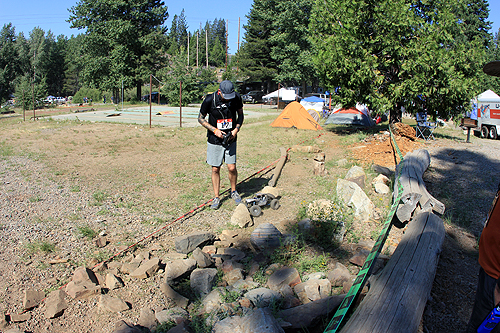
Steering Tips
Super Servo Arm- Kits and ready to runs include plastic servo arms that will certainly get you underway, but in an Axialfest Rock Racing competition, they have been known to strip out. Axial’s option aluminum servo horns are some of the best available and are often used by builders in builds beyond installs in Axial vehicles. These option horns are available for different servo splines, have a double clamp and two holes for the steering link. The strong aluminum horns will hold up to the abuse on the course.
Servo Upgrade- Many drivers upgrade to higher torque servos with strong metal gears to withstand the abuse on the course. If you do upgrade, consider using a servo with an aluminum case. The mounting ears on a plastic case servo can break on hard impacts. At the very least, use a wide head screw to support the servo in the mounting bracket.
Steering Links- Steering links are often the first thing to hit rocks and other on course debris on the front of RR10 Bombers, Wraiths and on SCX10’s. Plastic links can flex, lead to weakening or can even break. Many upgrade to aluminum links to handle more abrasive action and still deliver precise steering.
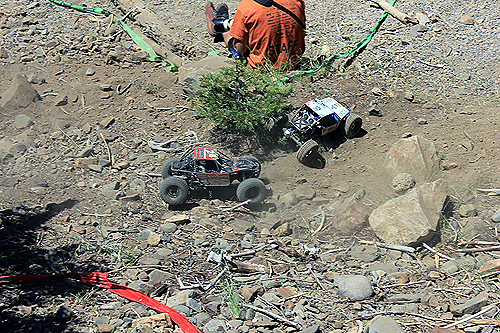 Suspension Work
Suspension Work
Shocks- Before heading out on the rock racing course or 5K, its a great idea to rebuild your shocks with new oil and even better replace the seals. The shocks on a rock racer or even trail truck are among the most abused shocks in RC. Not only do they move up and down, but receive side loading as well that can wear on the shock and even cause it to leak. After rebuilding your shocks, make sure they have some “wiggle room” don’t clamp down on the shock mounts with the retaining screws. Let them slide on the mounting bolts a bit. This will give the shock additional movement that will lessen the wear of the shocks internals.
Trailing Links- The lower trailing links see a lot of ground action while damping the rig on the trails. When using plastic links, check to make sure the ball ends have not elongated and may break during the run. Use the aluminum plates to make the plastic links more rigid or there are plenty of aluminum options available from various Axial supporting aftermarket manufacturers.
Driveline Tips
Screw Pins- Screw pins are used to secure the universal yokes to the axle drive pinions, if your rig doesn’t have them and you have a through-hole in the bevel pinion shaft, go with a screw-pin instead of a set-screw. This will ensure drive instead of a set-screw that can back out and slip. Use thread-lock here too of course.
Universals- We’ve seen some torn-up universals in our day. These components take a lot of abuse. Replacing the cross-pins before your course run can be a good idea. At the very least, check your universals for binding or regrease them if they look dry.
Bearings- Do you want to be “The Squeaky Guy?” Bearings take a lot of abuse and as they get covered in dirt or submerged in water, you risk the chance of bearing failure. If you hear squeaking, consider cleaning your bearings, blast them with a cleaner and re-oil them. Some go so far as to repack the bearing with grease. A bad bearing can eventually wreak havoc on your driveline on the trail. Fix it before it causes other possibly more expensive problems or dropping out of the race.
Gears- This is an important topic here. Many of crunchy transmissions have been heard along the trails at Axialfest. During your pretrip check, take a look at all of the gears. Do any look sharp, missing parts of their teeth, is your gearcase full of metal dust? Don’t leave it to a trail run to find our you needed to replace gears. In the axles, make sure the gear lash is correct between the bevel pinion and ring gear. Shims may be used to adjust gear lash. Inside of the center transmission, make sure your gears are well lubricated with grease. And finally, your pinion and spur. Make sure your mesh is correct, not too loose that your gears can skip and not too tight that it binds.
Slipper- Your slipper clutch is often the line of defense to protecting your transmission. When your rig gets caught up in a gap in the rocks and you pin the throttle, the slipper will slip rather than the gears skipping. You want the slipper tight enough so you get through gnarly obstacles, but you do need that slip for protection. A little trial and error works here in terms of setting. Always lean toward the loose side to start with.
Grease- As mentioned above a number of times. Grease, grease grease. Grease the gears, consider greasing the bearings, add grease to metal shafts inside of the axles, grease universal joints. Grease will keep these parts smooth and offer some protection from the elements.
Axle caps- The ends of the axles are secured with screws which if they back out can wreak havoc in many ways. Place a small dab of CA glue under the screw head before installing it to help secure it and prevent it from backing out during your run.
What To Carry
Parts Supplies- Beyond prepping your rig for the course, you should prep for those what if moments. What if a screw falls out, what if a part breaks. It’s a good idea to carry a small parts bin of hardware with you at all times. Pack the bin with an assortment of screws, nuts, set-screws, body pins, flanged bushings for the steering knuckles, axles pins and washers in case something falls off on a run. Next you’ll want to carry some more substantial parts like a spare shock, some spare links, a spare center universal set-up. An extra servo horn or even and extra servo. There are even some drivers who will pack an entire assembled axle, or center transmission, just in case…
Batteries- During a rock race or during the 5K you may need to swap batteries. For better performance or to make it to the end. Have several packs on hand for the events and stored in a LiPo sack for safe transport.
Tools- You know those little bags of allen wrenches and the box wrench that came with your kit? They make great lightweight travel tools and can fix most of the issues you’ll have to deal with on your rig. Now granted hand tools make the job easier, carry the basics, 1.5mm, 2.0mm and 2.5mm hex drivers; 5.5mm and 7.0mm nut drivers, long nose pliers, scissors and cutters can also be useful. Place them in a bag and put them in your backpack during your adventure.
Survival- Always carry water with you for hydration, in fact its pretty much mandatory for the 5K and a must for between rock racing runs.. Cisco Grove is at a higher elevation and having water on hand will keep you hydrated during your hikes. Also have some nutrition with you. Some power bars, trail mix or other foods can take the edge off your hunger while competing on the courses. It’s also good to have a small first aid kit in case you get a scratch or scrape on the trail. Wear a hat, use moisture wicking clothing, wear proper footwear such as Altra shoes that will keep you sure footed on the course.
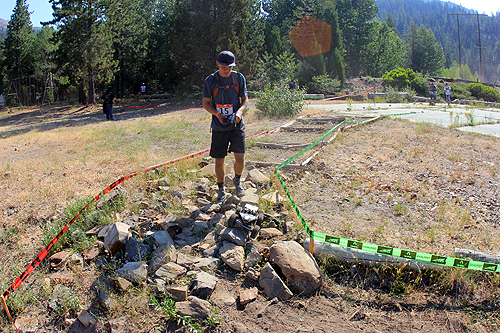
The Axialfest Rock Racing and Altra Ultra events test both man or woman and machine. It’s a good idea to prep both your rig and yourself for these events. Train ahead of time for quick sprints and lengthy runs. Be prepared for all types of weather too. It can be cold in the mornings and hot in the afternoons. These events at Axialfest are to promote fun first and foremost, but racing can always get intense and being prepared can help you make it to the finish with success.

